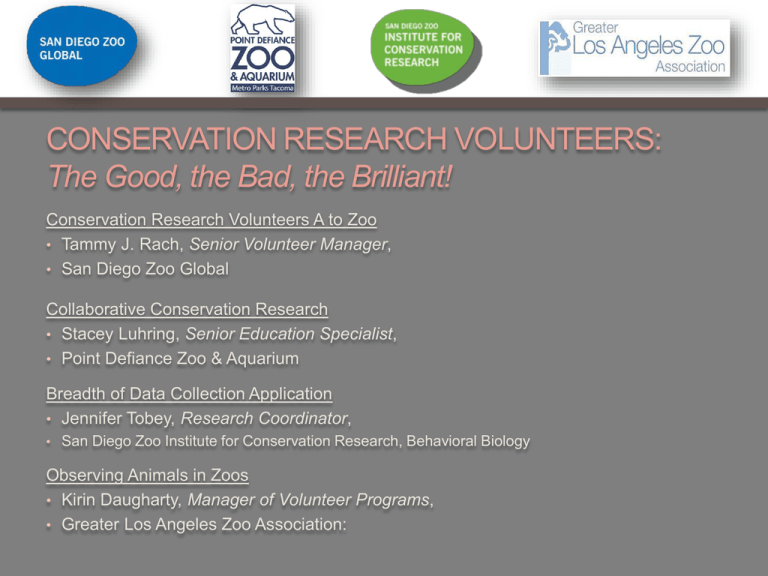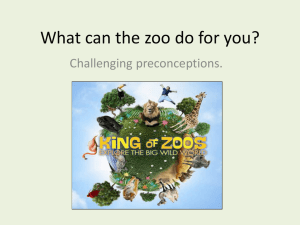CONSERVATION RESEARCH VOLUNTEERS: The Good, The Bad
advertisement

CONSERVATION RESEARCH VOLUNTEERS: The Good, the Bad, the Brilliant! Conservation Research Volunteers A to Zoo • Tammy J. Rach, Senior Volunteer Manager, • San Diego Zoo Global Collaborative Conservation Research • Stacey Luhring, Senior Education Specialist, • Point Defiance Zoo & Aquarium Breadth of Data Collection Application • Jennifer Tobey, Research Coordinator, • San Diego Zoo Institute for Conservation Research, Behavioral Biology Observing Animals in Zoos • Kirin Daugharty, Manager of Volunteer Programs, • Greater Los Angeles Zoo Association: CONSERVATION RESEARCH VOLUNTEERS: A TO ZOO Tammy J. Rach Senior Volunteer Manager San Diego Zoo Global Data collection, processing, birth watches, field work, lab work and more. Safety training, keys to effective organization, ensuring consistent data collection, and inter-departmental success. The ood • Dozens of worker bees at your disposal • Unlimited potential • People who WANT to do the grunt work • A plethora of interesting personalities and skill sets The ad • Dozens of worker bees at your knees, wanting to suck up your time because • You are cool • You are the link to cool stuff • They want your job • Unlimited potential that will not come to fruition unless you make it so (investment of time, energy, and sometimes resources) • People who DON’T want to do the grunt work • A plethora of interesting personalities and skill sets Critical for Every Assignment • Skill Sets • Safety Training • Keys to Effective Organization • Inter-Departmental Success Applied Plant Ecology Applied Animal Ecology Behavioral Biology Genetics Library Mountain Yellow-legged Frogs Panda Research Reproductive Physiology Wildlife Disease Labs Birth Watches Databases • Design • Input • Management Field Work Data Collection & Processing • Consistency Conservation Research Volunteers: Are they for you? Conservation Research Volunteers A to Zoo • Conclusion – with the right set-up and effective organization anything is possible… COLLABORATIVE CONSERVATION RESEARCH Stacey Luhring, Senior Education Specialist, Volunteer Services & Visitor Experience Point Defiance Zoo & Aquarium Volunteers Assisting with Research • Behavioral observations • Citizen Science Initiatives • Scientific Diver PDZA : Dive Program • Started in 2007 • 14 Divers divided into two teams • Responsibilities: • Husbandry of exhibits • Interpretive dive in South Pacific exhibit Conservation Research & Scientific Divers • Aquarium needs • Small staff needing more hands • Staff wanting to do research but no time • Aquatic world comes in pairs • Volunteer needs: • New opportunities • Keep motivation strong = retention Scientific Divers • Hosted & taught certification class recognized by the American Academy of Underwater Sciences • Trained on underwater scientific research techniques • Allows volunteers to collect in the field and conduct research projects for PDZA and other agencies • Gives PDZA additional bodies with the knowledge and skill for research projects Projects currently underway • Rockfish Monitoring Survey • Collaborative project with Seattle Aquarium • Grant from the NW Zoo & Aquarium Alliance • Information used for health of Puget Sound and listed species. Drawbacks of Volunteer Involvement • Staff time to train = less time maintaining exhibits • Return on class investment (few took test) • Various schedules (staff & volunteers) • Large commitment Benefits of Volunteer Involvement • More Bodies = More accomplishments for small staff • Additional data collection • Doesn’t deplete staff who are managing exhibits • Multiple projects if enough bodies • High incentive and motivator for volunteers • Personal satisfaction for volunteers in doing conservation work Breadth of Data Collection Application Jennifer Tobey, Research Coordinator Lance Miller, Scientist Institute for Conservation Research, San Diego Zoo Global Jeff Andrews, Associate Curator San Diego Zoo Global Breadth of Volunteer • Students • Other career professionals • “Just love it” Get them all on the same page!... How do you make sure that what you are getting is correct? -Training -Inter-rater reliability Not always the same each project! Leads to… Breadth of data collection and it’s application. Three Studies Bonobo Research • Individual recognition of bonobos • Reliability testing for behavioral events and behavioral states (r > .80) • Safety training (San Diego Zoo Safari Park) Bonobo Research • Data collected 3/15/2011 – 8/5/2011 • San Diego Zoo and San Diego Zoo Safari Park • Behavioral states (activity budgets) and behavioral events (R/R, affiliative and aggressive) • 275 hours of data Bonobo Research • Animal management • Presented to animal care teams at Zoo and Park • Submitting for publication Elephant • Periparturitional behavior and calf development in African elephants. • Long term data collection • Large volunteer pool; high retention rate • Safety & IACUC training Elephant • Data has been collected for 7 years (10 births) • Doubles as birth watch • 2 weeks prior to birth & continues 5 weeks after • Overnight: 6pm-6am (4 hours/shift) • Complements keeper data collection Elephant • Publications • Acknowledged • Authorship Data used to obtain firsts information for calves Management practices that support more natural birthing and rearing processes. Orangutan Up to 15 volunteers trained and actively collecting data over the study period. Long term data collection. Capture pre/post data for group dynamic changes as well as study changes pending. IACUC training and inclusion. Orangutan • Complex behavior • Proximity • Location in exhibit • Daily observations: 2 hour shifts/3 shifts a day • Animals on exhibit: dealing with public questions and interest Orangutan • Baseline Data • Publication • Future graduate work? OBSERVING ANIMALS IN ZOOS Kirin Daugharty Manager of Volunteer Programs Greater Los Angeles Zoo Association Participating in local and national studies and supplying valuable info that helps captive populations of endangered species. Collecting data, time observations, and in office data tabulation. Learn effective set-up and team strategies for utilizing volunteers in conservation research. Observing Animals in Zoo’s Training Observing Animals in Zoos • UCLA accredited course • 13-weeks • Observational techniques • What’s an ethogram? • How/What do you tabulate? • Solo studies • Group project The Making of a Research Volunteer What do the volunteers do? SO MUCH! • Observe animal introductions • Breeding behaviors • Birth watch • New feeder/enrichment device behaviors • New enclosure behaviors What do the volunteers do? Observe What do the volunteers do? Tabulate What do the volunteers do? Enter data Use of information Animal care Nationally • Enrichment • Conferences • Animal Care • giant river otters Effective set-up Solid Goal or Mission • Why are you starting the program? • Is it a long term or short term need? • What are you trying to answer or address? Effective set-up Volunteer Administrator involvement • “Red flag” applicants • Full/Combined recognition • Consistency in safety/emergency/HR policies Effective set-up University association Provide added resources • Biomedical library • Facilities/equipment • Funding • Reputation Effective set-up • • • • Great introduction to zoo settings, procedures, and philosophies. Volunteers play an important role in animal management and conservation. Teamwork: data collection, tabulation, data entry. Each institution is different and will approach in its own way. QUESTIONS?




